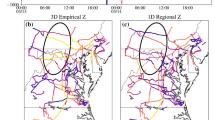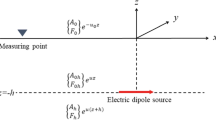Abstract
Recently several cases of observations of unipolar magnetic field pulses associated with earthquakes at different points (California, Italy, Peru) have been recorded. The paper attempts to model unipolar magnetic field pulses based on one mechanism that should be omnipresent for all measurement points, namely, the magnetic field diffusion through a conductive medium. The structure of magnetic fields supported by electric current sources is thoroughly modelled. The source of electric current is considered as an elongated volume of finite cross-section being immersed in a conductive medium. To model the unipolarity feature of the observed pulses prior to and at the earthquake main shock, the electric current of the source is of impulse form. Special attention is paid to the differences in the pulse structure (as amplitude envelope and the pulse width) that are measured by various magnetometers (fluxgate or search-coil). An analysis and comparison with recorded magnetic field pulse characteristics reveal that the observed unipolar pulses may have a common genesis, an electric current source within a conductive medium such as the earth crust.










Similar content being viewed by others
References
Bayin SS (2006) Mathematical methods in science and engineering. Wiley, Hoboken. ISBN 9780470047422
Bleier T, Dunson C, Maniscalco M, Bryant N, Bambery R, Freund F (2009) Investigation of ULF magnetic pulsations, air conductivity changes, and infrared signatures associated with the 30 October Alum Rock M5.4 earthquake. Nat Hazards Earth Syst Sci (NHESS) 9:585–603
Bleier T, Dunson C, Roth S, Heraud JA, Lira A, Freund F, Dahlgren R, Bambery R, Bryant N (2012) Ground-based and space-based electromagnetic monitoring for pre-earthquake signals. In: Hayakawa M (ed) Frontiers of earthquake prediction studies. Nihon-Senmontosho-Shuppan, Tokyo
Bortnik J, Bleier T, Dunson C, Freund F (2010) Estimating the seismotelluric current required for observable electromagnetic ground signals. Ann Geophys 28:1615–1624
Boyd TJM, Sanderson JJ (1969) Plasma dynamics. Barnes and Noble Inc., New York, p 348
Christman L, Connor D, McPhee DK, Glen JM, Klemperer SL (2012) Characterizing potential earthquake signals on the stanford-USGS ultra-low frequency electromagnetic (ULFEM) Array. In: American Geophysical Union, Fall Meeting 2012, abstract #NH41B-1608. https://earth.stanford.edu/researchgroups/crustal/publications/abstracts
Di Lorenzo C, Palangio P, Santarato G, Meloni A, Villante U, Santarelli L (2011) Non-inductive components of electromagnetic signals associated with L’Aquila earthquake sequences estimated by means of inter-station impulse response functions. Nat Hazards Earth Syst Sci (NHESS) 11:1047–1055. https://doi.org/10.5194/nhess-11-1047-2011
Dunson JC, Bleier TE, Roth S, Heraud J, Alvarez CH, Lira A (2011) The pulse azimuth effect as seen in induction coil magnetometers located in California and Peru 2007-2010, and its possible association with earthquakes. Nat Hazards Earth Syst Sci (NHESS) 11:2085–2105. https://doi.org/10.5194/nhess-11-2085-2011
Enomoto Y, Chaudhri MM (1993) Fracto-emission during fracture of engineering ceramics. J Am Ceram Soc 76:2583–2587
Fenoglio MA, Johnston MJS, Byerlee JD (1995) Magnetic and electric fields associated with changes in high pore pressure in fault zones: application to the Loma Prieta ULF emissions. J Geophys Res 100:12951–12958
Fifolt DA, Petrenko VF, Schulson EM (1993) Preliminary study of electromagnetic emissions from cracks in ice. Phil Mag B67:289–299
Freund F (2002) Charge generation and propagation in igneous rocks. J Geodyn 33:543–570
Freund FT, Freund MM (2015) Paradox of peroxy defects and positive holes in rocks. Part I: effect of temperature, 2015. J Asian Earth Sci 114:373–383
Freund FT, Takeuchi A, Low BWS, Post R, Keefner J, Mellon J, Al-Manaseer A (2004) Stress-induced changes in the electrical conductivity of igneous rocks and the generation of ground currents. Terr Atm Ocean Sci (TAO) 15:437–467
Gershenzon NI, Bambakidis G, Ternovskiy I (2014) Coseismic electromagnetic field due to the electrokinetic effect. Geophysics 79(5):E217–E229. https://doi.org/10.1190/geo2014-0125.1
Gokhberg MB, Gufel′d IL, Gershenzon NI, Pilipenko VA (1985) Electromagnetic effects under the breaking the crust. Physics of Earth 1:72–87 (in Russian)
Hayakawa M (2013) Earthquake prediction studies: seismo electromagnetics. TERRAPUB, Tokyo, p 168
Hayakawa M, Molchanov OL (2002) Seismo electromagnetics: lithosphere-atmosphere-ionosphere coupling. TERRAPUB, Tokyo, p 477
Leeman JR, Scuderi MM, Marone C, Saffer DM, Shinbrot T (2014) On the origin and evolution of electrical signals during frictional stick slip in sheared granular material. J Geophys Res Solid Earth 119:4253–4268. https://doi.org/10.1002/2013JB010793
Masci F, Thomas JN (2016) Evidence of underground electric current generation during the 2009 L’Aquila earthquake: real or instrumental? Geophys Res Lett 43:6153–6161. https://doi.org/10.1002/2016GL069759
Molchanov OA, Hayakawa M (1995) Generation of ULF electromagnetic emissions by microfracturing. Geophys Res Lett 22:3091–3094
Molchanov OA, Hayakawa M (1998) On the generation mechanism of ULF seismogenic electromagnetic emissions. Phys Earth Planet Inter 105:201–2010
Nenovski P (2015) Experimental evidence of electrification processes during the 2009 L’Aquila earthquake main shock. Geophys Res Lett 42:7476–7482. https://doi.org/10.1002/2015GL065126
Nenovski P, Chamati M, Villante U, De Lauretis M, Francia P (2013) Scaling characteristics of SEGMA magnetic field data around the Mw 6.3 Aquila earthquake. Acta Geophys 61(2):311–337. https://doi.org/10.2478/s11600-012-0081-1
Scoville J, Heraud J, Freund F (2015a) Pre-earthquake magnetic pulses. Nat Hazards Earth Syst Sci (NHESS) 15:1873–1880. https://doi.org/10.5194/nhess-15-1873-2015
Scoville J, Sornette J, Freund FT (2015b) Paradox of peroxy defects and positive holes in rocks Part II: outflow of electric currents from stressed rocks. J Asian Earth Sci 114(2015):338–351
Shkarofsky IP, Johnston TW, Bachynski MP (1966) The particle kinetics of plasmas. Addison-Wesley, Boston
Surkov VV, Molchanov OA, Hayakawa M (2003) Pre-earthquake ULF electromagnetic, perturbations as a result of inductive seismomagnetic phenomena during microfracturing. J Atm Solar Terr Phys (JASTP) 65:31–46
Villante U, De Lauretis M, De Paulis C, Francia P, Piancatelli A, Pietropaolo E, Vellante M, Meloni A, Palangio P, Schwingenschuh K, Prattes G, Magnes W, Nenovski P (2010) The 6 April 2009 earthquake at L’Aquila: a preliminary analysis of magnetic field measurements. Nat Hazards Earth Syst Sci (NHESS) 10:203–214
Wait JR (1982) Geo-electromagnetism. Academic Press, New York
Yamazaki K (2016) An analytical expression for early electromagnetic signals generated by impulsive line-currents in conductive Earth crust, with numerical examples. Ann Geophys 59:G0212. https://doi.org/10.4401/ag-6867
Acknowledgements
The author is grateful to professors S. Shanov and F. Freund, Dr T. Bleier and Dr R. Glavcheva for stimulating discussions on the topic, their comments and invariable support. The author thanks prof F. Freund for his constructive suggestions during the review process.
Author information
Authors and Affiliations
Corresponding author
Appendices
Appendix 1
The distance r between the measurement point r(x, y) and the axis of the source electric current [placed at point (x = 0, y = 0)] may exceed the cross section parameters x0 and y0 (r ≫ x0 or y0). If x0 (or y0) ≫ y0 (or x0), a strip current geometry (fault-like plane) is formed. Otherwise, if the cross section parameters are of comparable size, i.e. x0 ≈ y0, and the distance r(x,y) exceeds x0, y0, the error function in expressions (5a) may be safely approximated by:
where u is the function argument: u is equal to \( \frac{{\widetilde{x}}}{{2\sqrt {\widetilde{t}} }} \) or \( \frac{{\widetilde{y}}}{{2\sqrt {\widetilde{t}} }} \); \( u \) is equal to \( \frac{{\widetilde{x}_{0} }}{{\sqrt {\widetilde{t}} }} \) or \( \frac{{\widetilde{y}_{0} }}{{\sqrt {\widetilde{t}} }} \), respectively. The final expressions are:
Let us introduce a diffusion time scale of medium conductivity σ: τd ≡ \( \mu_{0} \sigma r^{2} \), where r ≡ \( \sqrt {(x^{2} + y^{2} } \). Let us denote \( j_{0} \left( {2x_{0} } \right)\left( {2y_{0} } \right) \) as I0 (the current source strength). Further, I0 is considered constant irrespectively of the magnitudes of the actual cross-section parameters \( (x_{0} , y_{0} ) \). Then the magnetic field component Bx varies as:
The magnetic field expression (when x0/y0 ≈1) may be applied to a square or cylindrical (tube) current geometry of radius xo ≈ yo. In that case, the azimuthal magnetic field component Bφ, supported by a current of cylindrical cross section of radius R will be expressed by (11).
Let us now consider a strip current of width 2yo and infinite length along the x axis (x0 → ∞). The electric current density \( \vec{j} \) 0 is parallel to the z-axis. Then:
where y is the distance to the middle plane (defined as y = 0) of the strip current. This expression yields the magnetic field produced by electric current density \( j_{0} \) along the z axis permeating an infinite strip current of thickness 2y0.
The strip current model may have various applications in geo-electromagnetism. One of them is electric currents that are released in soil through the earthing systems (this occurs mainly in a shallow layer of some depth of higher conductivity). Other strip (or layer) structures of high conductivity (σ ≈ 10−1 ÷ 4 S/m) are the fault, water basin systems (river, lake, sea, ocean), where electric currents (induced mainly by global geomagnetic activity) may be concentrated.
Expressions (3) describe the magnetic field variations in space and time produced by transient electric currents of finite extension (along x and y). Naturally, these general expressions should be consistent with the expression of the magnetic field produced by a line current impulse. These expressions should also represent a generalization of the well-known formula of the magnetic field produced by a line current in static approximation (t → ∞).
First, let us check the validity of (11) at the limit (\( y_{0} \to 0 \) and \( x_{0} \to 0 \)). Applying the L’Hôspital rule to expression (10a), from straightforward algebra one gets:
where Bx is now replaced by the symbol \( B_{line,tr} \) and the coordinate y - by r. Further, when there is a constant current source, e.g. switched on at time t = 0, the current source ~ δ(t) in (1) should be replaced by the Heaviside’s function θ(t). Then, the magnetic field at moment t will be simply derived by integration over \( \widetilde{t} \):
For t → ∞, expression (14) expectedly reduces to:
which is identical to the magnetic field that is circumferential to an infinite wire carrying a current of strength Io.Attention should be paid to the ratio Bline,tr/Bline,st and its time profile. At its maximum (when t = tpeak = τd/8), this ratio becomes equal to ~ 4.5. This suggests that at the given measurement point the transient magnetic signal emerges with greater amplitude (4.5 times) compared to that produced by same current strength under static conditions.
Appendix 2
In fact, unipolar pulses have been recorded by several kinds of magnetometers, among them fluxgate and search-coils magnetometers. Fluxgate magnetometers are designed to measure DC fields, while the searchcoil - AC fields. Concretely, the search-coil sensor is built on the induction principle. The induced voltage, say \( \epsilon \), is proportional to the time derivative of the magnetic flux as follows from the Faraday’s law, i.e.
where S is the cross-section and n is the number of turns in the sensor coil. The coil sensor is characterized by self-inductance L. It also features resistance R and capacitance C. Generally speaking, the transfer function between the output (the measurable voltage, Vout) and the flux density (the magnetic field, B) of the induction sensor depends on both the resonance frequency ωr (equal to 1/sqrt(LC) and the RC constant. However, their effects should be negligible under low-frequency conditions: ω ≪ ωr and ω ≪ 1/RC (fulfilled for frequencies below 1 Hz, the fluxgate sampling frequency). This condition is practically satisfied when the frequency is less than 10–100 Hz. Note that the unipolar pulses observed by fluxgate magnetometers (of sampling frequency of 1 Hz) are well below this upper limit.
Examining unipolar magnetic pulses recorded by fluxgate magnetometers under these low-frequency conditions, the validity of Eq. (16) is confirmed.
Rights and permissions
About this article
Cite this article
Nenovski, P. Underground current impulses as a possible source of unipolar magnetic pulses. Acta Geod Geophys 53, 555–577 (2018). https://doi.org/10.1007/s40328-018-0219-y
Received:
Accepted:
Published:
Issue Date:
DOI: https://doi.org/10.1007/s40328-018-0219-y




